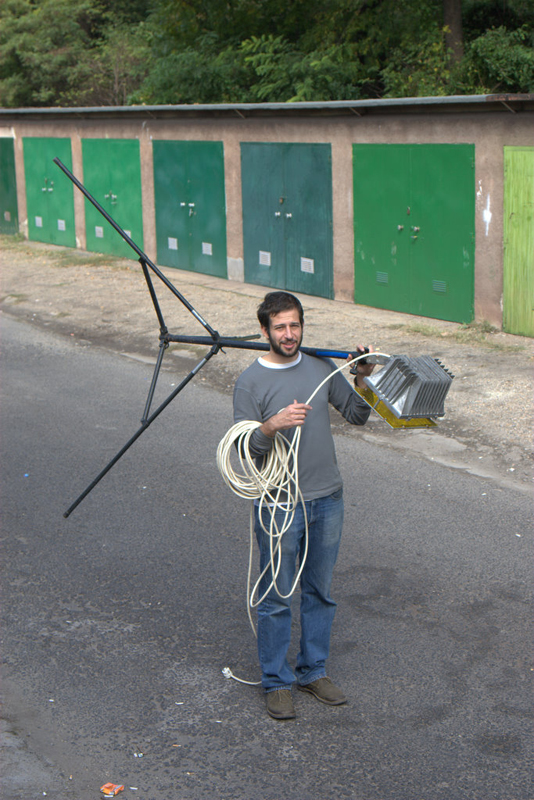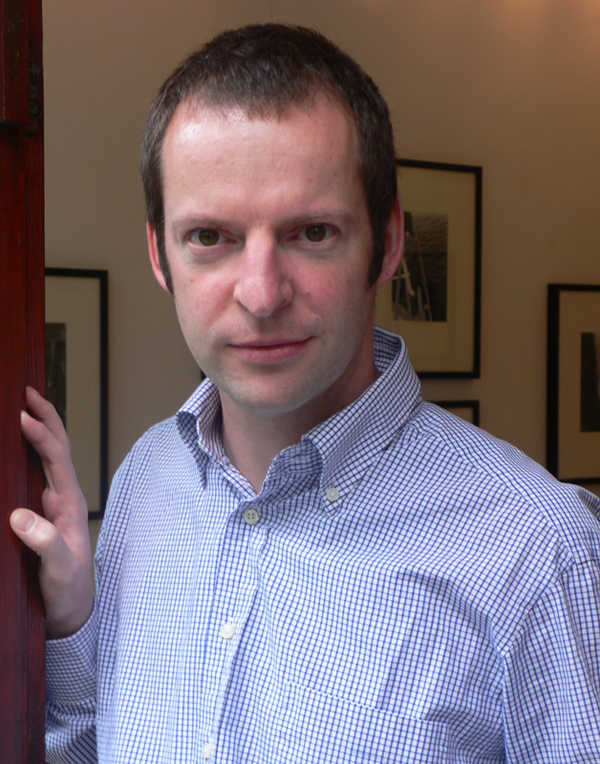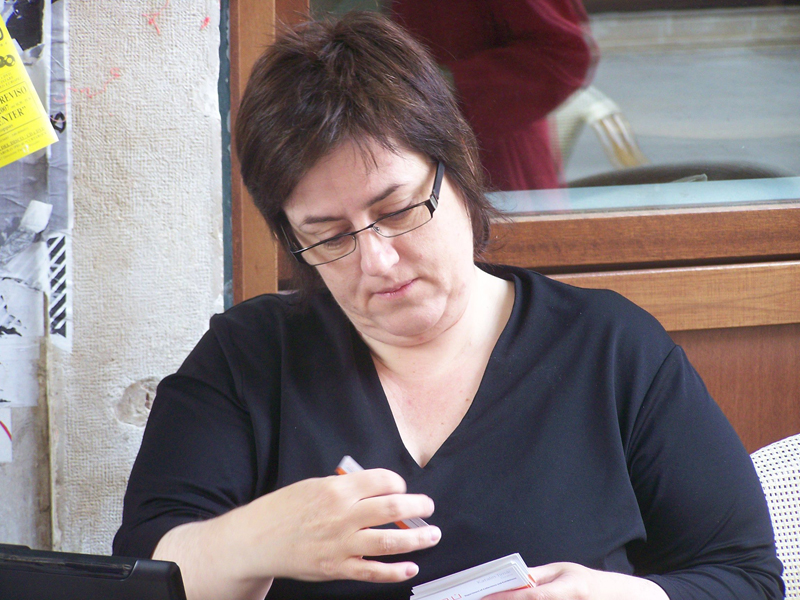A Conversation with Attila Pőcze and László Gergely (Interview)
László Gergely is a founding member of Lumen Photography Foundation and Lumen Gallery (since 2002). He lives and works in Budapest. The term Tehnica Schweiz is used for his collaboration with Péter Rákosi (since 2004). Tehnica Schweiz is a member of POC – Piece of Cake, an international network of photographers (www.pocproject.com). Gergely László is an alumnus of ICP – NYC and has exhibited at many institutions in Europe, including M?csarnok (Kunsthalle, Budapest); NBK Berlin; Witte de With (Rotterdam); Norwich Gallery; and the Vienna Secession.
Attila P?cze opened Vintage Gallery (Budapest) in 1996. He studied car design at the Technical University in Budapest, where he also ran Gallery 11. After completing his studies he worked as a fellow at the Hungarian Museum of Photography, organizing exhibitions, archiving artists’ works, etc. He opened Vintage Gallery (Budapest) in 1996.
Katalin Timar: My name is Katalin Timar, I’m a curator and I often work with photography. I have here with me Attila P?cze and László Gergely. Attila is the owner of Vintage Gallery, a private, commercially run gallery for Hungarian photography, and Gergely represents the Lumen Foundation. The Lumen foundation runs Lumen Gallery, which focuses on photography as well. First, I’d like to ask each of you to define in depth what you are working on and how you see each other’s activity within the Hungarian photography scene?
László Gergely: Lumen has existed for eight years now, and was founded by some friends and myself with the goal of creating a platform for artists of our kind, people who are sort of in our footsteps, or who share our destination.
KT: Can you explain what you mean?
LGL: At the time we were quite young, so I think the goal of Lumen is always changing in accordance with what we’ve become. As does our profile, pace, and program. We have, as you can see, a flexible sort of institution, always trying to adapt to present needs and possibilities We have been struggling to formulate a course, but recently gave up on it. We came to realize that Lumen is really about the interests of the people who are running it. We like to invite people who do art that we ourselves wish we had done.
KT: Do you focus on any specific generation of artists or do you intend to cover the whole spectrum?
LGL: Yes, it started off as a foundation, an organization with the goal of helping the emerging young artists with their first integration in theto a wider art or photography scene. We etry to find things that are interesting to us. Right now, I am personally interested in more political works that have an interesting process, which are process based, which question the given medium. But we concentrate on photographic practices. Lumen takes its name from the Latin for “light”.
KTKY: Is Lumen Lumen also a space for a collection, or is it more a space where you present interesting work?
LGL: We have had both. Lumen fluctuates; the more active we are as artists the less energy we can afford to invest in organizing things. And, I mean, we are also aging. I’ve been very active as an artist and an activist as two separate parts that was of my identity. Nowadays, I focus more on my art. It’s mostly a time management problem that I have learned to cope with in the past years. I mean, I think I had a lot of ideas about what Lumen could be as an institution, but neither of us ever had the wish to put all this work into getting it all done, and then eventually to run it, so we had to find the least energy-consuming way of getting things done.
KT: When it comes to different generations, Vintage is a gallery where many different generations of photographers have appeared..
Attila P?cze: Yes. I founded the gallery in 1996. I was also quite young when I started, and in the contemporary field I generally represented my generation. But I’m interested in the history of photography and art, and I try to represent the artists who are really on the so-called “cutting edge” of their time, or who are producing works that were parallel with their times.
KT: Who is the oldest of the artists?
AP: Artists such as Kertész, Moholy-Nagy, and Munkacsi, and also others who are not well known internationally, such as Imre Kinszki. My institution is much more simple and classical than the big high-tourism areas. It is a small commercial gallery, and we produce catalogues and participate in art fairs as well.
KT: How do you think your activities in promoting vintage photography, photography of the 1960s and after–historical photographs, as it were-support your efforts of promoting young contemporary artists, and what sort of connection there are between them?
AP: Generally, I don’t really see these things separately. I think history or knowledge of the past helps us understand current events. And as for the audience-there is no one kind of audience. Maybe people are more interested in contemporary art and less in historical things. But these things really help each other and you can build on that, build on different kinds of knowledge. I also think, for example, that a young artist must know history –maybe just in order to forget it, and build completely new things. These could be very different strategies, but the knowledge is very important.
KT: As far as I can see, Vintage fills a kind of gap in the Hungarian artistic scene with two endeavors: the publication of catalogues that only mainstream museums or big institutions normally produce, and the exhibition of historical photography in the context of your exhibit. In that sense, as far as I can see, you are doing something unique in the Hungarian art scene. With the space that Lumen runs, you try to create a flexible platform. This formula is unique, it is very different from the way other institutions work. Even with a small or relatively flexible institution, there are so many constraints-at least within the Hungarian scene. Due to these constraints, the exhibitions rarely reflect the interests of the people involved. I’m curious how you see each other’s institutions, and what position you see the institution filling within the art scene.
LGL: Vintage Gallery was one of the few places to look for photography. It always represented the artist community I had a lot of respect for when I first started to learn about art and photography, and this is the way I still see it. More than being a historical place, it is a part of my personal artistic experience – Vintage artists are important to me. Vintage is a high profile gallery, it’s always been there, and it never really changed, and this gave us a feeling of comfort.
KT: Vintage maintains a very high standard, it’s very reassuring.
AP: You’re right, but that’s why I’m always envious of Lumen’s activities as [there is] much more freedom, a lot of young energy and flexibility, and also the kind of international vision that I miss in my own area.
KT: You mentioned an international outlook and connections with the outside world. Perhaps this is a good moment to discuss your motivations and interests, as well as the reasons you both choose to participate in Paris Photo. What do you think is gained by your participation? What do you think you contribute and how do you see your presence at Paris Photo?
LGL: It wasn’t obvious that Lumen should participate. We probably won’t keep on going to Paris Photo, like Vintage, but we see it as a one-time opportunity for Lumen to be present at an event where a lot of important people look for artists. We generally see this as a good opportunity, again, for young people in Hungary to be introduced to a broader scene, to be recognized and open the doors to future opportunity. As far as Lumen goes, we would like them to know us, but we are still not at the point of articulating what we are, and definitely not what we will be in the future. We probably won’t be seen us as a future commercial gallery because that’s not yet our mission. Therefore, maybe it’s good enough that people just remember Lumen as a sort of a “cool brand.” That’s why our presence at Paris Photo is something of an exception for us. Paris Photo is an art fair, it focuses on sales. Naturally, we will try to sell works, that’s all we can do.
AP: Paris Photo is an important art fair, and it does not exhibit only commercial galleries. There are also institutions, agencies, and sometimes non-profit organizations as well. It receives something like 40,000 visitors every year in five days. It is actually an important meeting place for curators, collectors, and art lovers. Paris Photo is trying to be more flexible than a classical art fair. So I think it’s a good idea from their point of view to invite Lumen as well.
KT: The fact that Vintage has been there since the beginning means that you’ve had a more vested interest in being there.
AP: Yes, otherwise we would be only in Budapest, so this really opens the doors to the international scene. We have been able to show our work at different institutions because of the curators we’d met at Paris Photo. We have long-term relationships, which started there. This is very important because it’s not always easy or simple to get financial backing. It seems to be a bit slow, and up to now we are still, let’s say national galleries, but I would like to open the gallery to the international scene, but this is not as easy as we’d like to imagine.
KT: Why?
AP: There are two reasons. First, because I always like to pursue a program in depth, I still want to fill in the gaps of the Hungarian history of photography, which I would like to present and represent. Second, the Hungarian audience and market are still too tiny to support important international artists.
KT: And how do you see this year’s Paris Photo, with its focus on East-Central Europe? Do you feel that you’re framed by it in a way that you would prefer not to be, or do you think this is a good thing that puts a spotlight on the region? Does the focus on Eastern Europe help you, or does it limit you?
AP: I think the East-Central European won’t be the only ones exhibiting East-Central European art and artists, but most of the other galleries will also show artists from the region, which is very important. I think it will be interesting to focus on these artists. We will be showing artists who participated in the Pompidou show and others like it earlier this year, in order to build on that experience.
KT: Such as the work of Tibor Hajas?
AP: Exactly.
KT: And as far as Lumen goes?
LGL: Well, I usually have problems with being categorized or framed, as you’d said, but that’s how it is now, and it’s just one of those things. I think my problem with participating in a program that is framed by a Central or Eastern European focus is that I don’t necessarily feel the significance of being Central or Eastern European in the arts. Such limiting terms create a preconception about those who are within the frame, their works and where they come from. I believe it is counterproductive, because it freezes the traditional East-West concept, and it also restricts the communication of independent and individual cultural identities. Still, we are happy to participate. It is a unique opportunity for us. Nevertheless, we are just going whichever way the wind blows, after all, and we are very happy to participate, and this is our opportunity…so we are like prostitutes at this point. Maybe this is too much…







